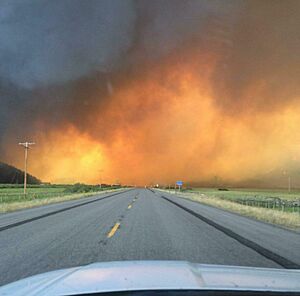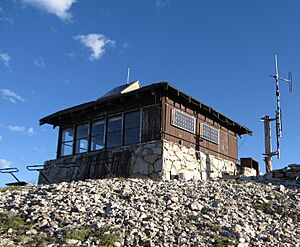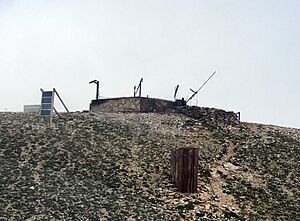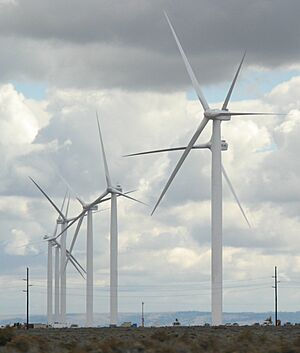Climate change in Wyoming facts for kids
Wyoming creates more carbon dioxide per person than any other state or country. This is because it burns a lot of coal to make almost all of its electricity. Each person in Wyoming is responsible for about 276,000 pounds (125,000 kg) of carbon dioxide each year.
Over the last 100 years, the average temperature in Laramie, Wyoming, has gone up by 1.5°F (0.8°C). Scientists predict that Wyoming's climate could change even more by the year 2100. Temperatures might increase by 4°F (2°C) in spring and fall. Summers could be 5°F (2.5°C) warmer, and winters could be 6°F (3°C) warmer.
Rain and snow patterns might also change. Summers could see a slight decrease in rain. Spring and fall might get 10% more rain, and winters could get 30% more snow. Very wet or snowy winter days are likely to become more common. Also, there could be more extremely hot days in summer. It's not clear how strong storms will be, but winter storms might happen more often and be more intense.
Contents
How Climate Change Affects Wyoming
Water Supplies
Many important rivers start in Wyoming. They flow into the Missouri River, Snake River, and Colorado River basins. Some parts of Wyoming have plenty of water, while others have very little.
Winter snow and spring snowmelt are very important for Wyoming's rivers. A warmer climate could mean less snow in winter and more rain instead. The snow that does fall might melt faster and earlier in spring. In the summer, if it doesn't rain much more, higher temperatures and more evaporation could make rivers and lakes have less water.
This would mean less water for irrigation (watering crops), making hydropower (electricity from water), public drinking water, and homes for fish and wildlife. It would also affect fun activities like boating and fishing, and even mining.
There could be more competition for water, especially in farming areas. In northeastern Wyoming, where there are many minerals, coal, and petroleum, mining and energy companies might compete for the small amount of water available in summer.
Water levels underground are already going down in some areas. This is because more water is being pumped out for farming and cities. Less spring and summer rain could make these underground water levels even lower.
Tourism and outdoor activities are a big part of Wyoming's economy. They also need enough clean water to thrive. Higher temperatures and less water flow could make water quality worse by concentrating pollutants.
Farming and Ranching
Warmer weather and drier soil might mean farmers need to water their crops more often. But these same conditions could also mean less water is available. This water is also needed by nature, cities, businesses, and others.
When it's warmer and drier, livestock (like cattle) tend to gain less weight. Also, the amount of grass and plants for them to eat in pastures can decrease.
Forests and Wildfires
Climate change could cause the amount of forest land in Wyoming to stay the same or shrink by 15-30%. Hotter and drier weather could lead to more frequent and intense wildfires. These fires threaten homes and forests. Drier conditions would also make ponderosa pine and lodgepole pine forests less healthy and more likely to burn.
Grasslands might grow into areas that were once forests in western Wyoming. Milder winters could also mean more insect outbreaks. These insects can kill trees, leaving dead wood that can easily catch fire.
Natural Habitats
Since the huge fires of 1988, when almost half of Yellowstone National Park burned, scientists have been studying how climate change might affect the park. Experts agree that the 1988 fires happened because of a dry winter, a hot, dry summer, and strong winds. Also, there were many old lodgepole pine trees that burned easily.
Normally, very large fires like those in 1988 don't happen often. But about 40% of Yellowstone is still at risk of large fires. Any increased fire risk from climate change would be a big problem. If old forests are replaced by younger ones, it could harm animals like pine marten and goshawk. It could also affect plants like northern twinflower and fairy slipper. More outbreaks of spruce budworms could also damage conifer forests.
Climate change also threatens high mountain areas. These areas could disappear in many places. Some mountain species, like arctic gentian, alpine chaenactis, rosy finch, and water pipit, might disappear from certain areas because they lose their homes. Even a small amount of warming and drying could reduce whitebark pine forests by up to 90% in 50 years. The nuts from whitebark pine trees and army cutworm moth caterpillars are important food for Wyoming's grizzly bears.
Whitebark pine forests might be replaced by Douglas fir trees. On lower slopes, forests could turn into treeless areas with plants like big sagebrush, Idaho fescue, and bluebunch wheatgrass.
What Wyoming is Doing About Climate Change
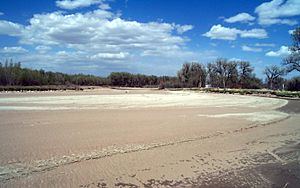
Renewable Energy
The Wyoming Infrastructure Authority (WIA) works to help build projects that use renewable energy. This includes energy from wind power, biomass (plants and waste), geothermal energy (heat from the Earth), and solar power. They also support small hydropower projects and projects that burn trash or make certain types of refined coal.
The WIA was created in 2004 to help Wyoming's economy grow by improving its electricity transmission (power lines). Since renewable energy projects use these power lines, the WIA reviews proposals for new projects.
Geothermal Energy
Wyoming is a good place for using geothermal energy directly. This means using heat from the Earth for things like heating and cooling homes, spas, farms, and greenhouses.
The Wyoming Geothermal Outreach Program teaches people about geothermal energy. It works with the government and businesses to make it easier to develop this energy. The program wants to promote clean heat and power, industrial growth, and economic development. They share information through workshops, a website, and information packets. They also visit other states to learn the best ways to develop geothermal energy.
Solar Power

The Wyoming Business Council offers grants to homeowners who want to install photovoltaic (PV) systems, also known as solar panels. The Residential Photovoltaic Grant Program helps people use solar power by paying for half the cost of installing a PV system, up to $3,000. This program has helped 139 homes install solar panels, which together can produce 80 kilowatts of power.
Because many people want these grants, the program uses a lottery system to choose who gets them.
Biofuels
Biofuels are fuels made from plants or animal waste.
- Wyoming has one ethanol fuel plant that can produce 12 million gallons (45,000 m³) of ethanol each year.
- There are 5 stations that sell E85 (a blend of 85% ethanol and 15% gasoline).
- There are 14 stations that sell biodiesel.
Wyoming offers a tax credit to companies that produce ethanol fuel. They can get $0.40 for every gallon of ethanol. To get this credit, at least 25% of the materials used to make the ethanol must come from Wyoming. The total credits given out cannot be more than $4 million per year. Also, no single producer can get more than $2 million per year.
Companies building a new ethanol plant can get tax credits for up to 15 years after construction finishes. If a company expands its production by at least 25%, it can also get more tax credits. However, these tax credits were only available until June 30, 2009.
Saving Energy
The Wyoming Energy Conservation Improvement Program (WYECIP) helps public and private nonprofit buildings save energy. This includes state offices, local governments, schools, colleges, hospitals, and nursing homes.
The Wyoming Business Council manages this program. They have approved 10 energy service companies that can help with energy-saving projects. Through this program, these organizations can hire approved contractors to make their buildings more energy efficient. They pay for these upgrades using the money they save on energy bills.


